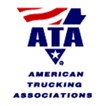The Hours Of Service Rules: Myths And Facts

By American Trucking Associations
Myth: The 11-hour driving limit and 34-hour restart provisions will significantly increase truck crashes and fatalities.
Facts: Since January of 2004 when the 11-hour driving limit and 34-hour restart went into effect, the large truck-involved fatal crashes fell from 4,335 (2003) to 4,190 (2007), while the number of truck miles traveled increased by 11B. The number of truck-involved fatalities has also decreased by more than 200 from 5,036 in 2003 to 4,808 in 2007. The truck-involved fatality rate (i.e., the number of fatalities divided by the miles traveled by trucks) has come down more than 10 percent and is at its lowest since the Federal Highway Administration (FHWA) began keeping records in 1975.
Operational flexibility from these provisions has also produced significant societal benefits that have lead to the betterment of drivers' lifestyles and sizable savings to motor carriers, shippers and consumers. The Federal Motor Carrier Safety Administration (FMCSA) estimated that eliminating the 11-hour driving limit and 34-hour restart would result in $2.2 billion in additional annual costs to the nation's economy.
During the five-year period the new hours of service rules have been in effect, billions of commercial motor vehicle driver hours have been recorded and hundreds of billions of miles have been traveled by trucks, proving the safety and benefit of these important provisions.
Myth: The 34-hour restart provision disregards the safety and health implications of cumulative fatigue on drivers.
Facts: FMCSA determined that the new hours of service rules through their combined effects would "not have a deleterious effect on the physical condition of the [truck] operators." Data from the Department of Labor's Bureau of Labor Statistics appear to support FMCSA's conclusion, showing that the rate of occupational injuries and illnesses in the trucking industry decreased by nearly 18 percent between 2004 and 2007.
FMCSA has repeatedly stated the need to view the various provisions of the hours of service rules, including the restart, as an integrated whole. FMCSA adopted hours of service regulations that included increased off-duty time (from 8 to 10 hours), a shorter driving window (from 15 to 14 hours and eliminated the deduction of off-duty time), an extension of the maximum daily driving limit (10 to 11 hours), a longer period of uninterrupted rest for sleeper-berth drivers (requiring 8 hours in the berth and another 2 hours off-duty), and sufficient time for two full sleep periods before restarting the workweek clock (the 34-hour restart).
In researching the driver's perspective, FMCSA learned that drivers value the 34-hour restart because it gives them more, not less, rest and time off-duty, including more time at home than the pre-2003 hours of service rules. An American Transportation Research Institute study on the impact of the new hours of service rules also found that the 34-hour restart, 10 hours off, and 11 hours of driving time are drivers' most preferred features.
Myth: The 34-hour restart will generate very long driving and on-duty times.
Facts: In the real world, this has not been the case. FMCSA found in their 2007 field study that only 27 percent of long-haul drivers were using any part of the maximum 11th driving hour. Only 8 percent of the restarts were exactly 34 hours, while 65 percent exceeded 44 hours.
As stated by FMCSA, "the longer hypothetical hours in driving and duty schedules" envisioned by critics of the 34-hour restart "requires an imaginary world with nearly perfect logistics for picking up and delivering a load."
SOURCE: American Trucking Associations
